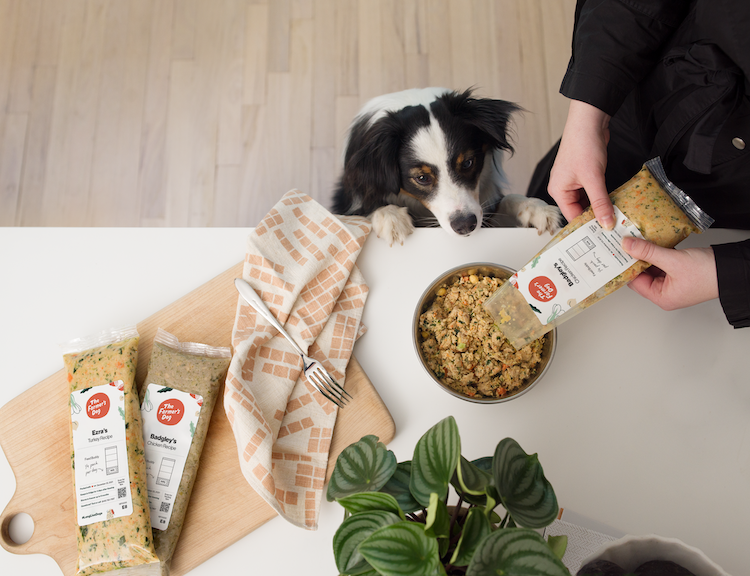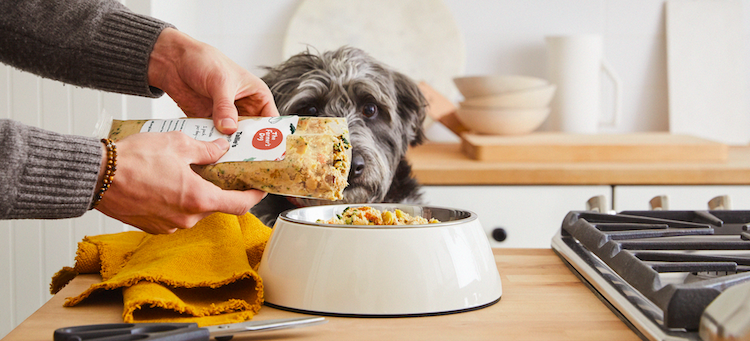Fresh, whole food from The Farmer’s Dog is a great choice for your dog’s health and your peace of mind. Our recipes are developed by board-certified nutritionists to be complete and balanced, and safe for daily feeding.
Because our food is made to human-grade standards (the same strict standards that apply to human food) you’ll always know exactly what you’re putting into your dog’s bowl. And because our food is delivered right to your door in pre-portioned packs, it’s easy to feed, too.
If you’re making the switch from kibble or canned, you may have questions about feeding our fresh food. You’ve come to the right place for answers.
How to store The Farmer’s Dog food
Since our food is made fresh and we donʼt use any preservatives, itʼs essential that you treat it like real food (because it is!). When you open the box, take a few packs out and put them in the fridge; store the rest in the freezer. Keep the food at a safe temperature until you’re ready to use it.
How to defrost The Farmer’s Dog food
To defrost The Farmer’s Dog food, just remove it from the freezer and put it into the refrigerator 12 hours before you want to feed it to your dog. Once thawed, the packs should keep safely in the fridge for up to four days.
To thaw the food more quickly in a pinch, you can run packs under cold water in your sink. However, please know that we prefer and recommend the refrigerator-defrosting method.
If your dog isn’t eating the food and it has been out of the fridge for 2 hours (1 hour if above 90°F), we recommend following USDA guidelines and tossing it out to be as safe as possible—the same way you would with fresh food for yourself and your human family members. Don’t put the food back in the refrigerator—once it’s been out that long, re-cooling won’t make it safe again.

How to feed The Farmer’s Dog food to your dog
If it’s your first time feeding The Farmer’s Dog, follow these step-by-step instructions.
The Farmer’s Dog makes it easy to serve the right number of calories for your dog. Our food comes in easy-to-serve packs, so there’s no measuring in cups or scoops.
For some customers, one pack = one portion.
For others, you may feed a portion of a pack at each meal.
Check the label for how much of the pack your dog should eat each day—and keep in mind that you’ll need to divide that portion into however many meals your dog eats. For example: If you feed your dog three times per day, split the “per day” amount into roughly three equal portions.
If you’re serving a full pack:
- Squeeze the top of the bag to push the food down a little and clear space at the top of the pack
- Cut straight across the pack near the top
- Squeeze the food out of the bag and into your dog’s bowl (you can fluff with a fork if you like!)
- Rinse out the bag, and please recycle
If you’re serving a half-pack or a quarter-pack:
- Squeeze the middle of the pack across the full width of the bag, moving the food toward the top and bottom of the pack
- Cut the pack in half
- Squeeze the food out of one of the half-bags. If you feed a half bag, squeeze out the entire half bag; if you feed a quarter bag, squeeze out half of that half bag
- If you squeeze the side of the bag gently and tap, the food will fall easily out of the bag
- Place the remaining food in the reusable container that comes with your food, and then store it in the refrigerator. If it’s out of the fridge for two hours (or one hour above 90°F), throw it out for safety reasons, just like you would with fresh food for humans.

“How do you figure out the right portions for my dog?”
Feeding a dog the right amount of food can make a big difference in their health—research shows that dogs in an ideal body condition can live up to 2.5 years longer than those who are overweight or obese.
When you sign up for a plan, we ask for several pieces of information about your dog. We use the information you provide to pre-portion your dog’s food for their calorie requirements—taking into account their age, weight, body condition, breed, activity level, spay/neuter status, and other factors. This more precise portioning system (no weighing, or guesstimating how many cups or scoops you need for a certain weight range) makes it easier to manage your dog’s weight.
Since every dog is unique, we use this as a starting place, and are always on hand to help with any necessary adjustments. And it’s easy to change your dog’s portions as they grow, or as directed by your veterinarian.
Mind the treats
Watch out for “extras.” Healthy treats can be a useful training aid and a nice reward for your dog, but they should never make up more than 10% of their daily calorie intake. Otherwise, you risk unwanted weight gain and the considerable health risks that go along with it.
Reach out with any other questions
Our team is available around the clock, every day of the year, to field your messages and phone calls. Just get in touch, and we’ll get you answers—and help your dog start eating healthy, fresh, complete and balanced food.
For further questions on feeding our fresh food, email [email protected].









